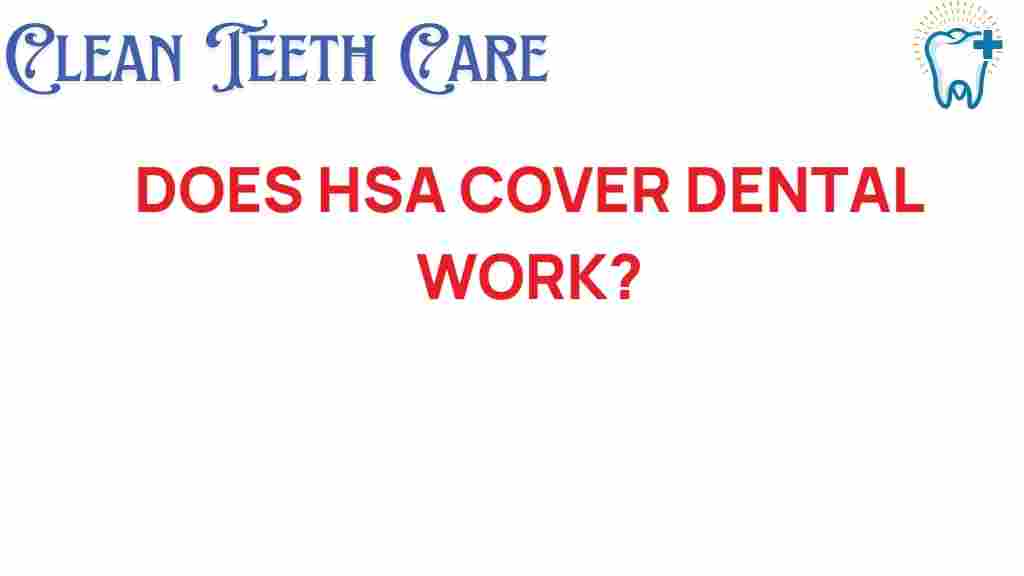Unraveling the Mystery: Does HSA Cover Dental Work?
Health Savings Accounts (HSAs) have become increasingly popular as a way for individuals to save for medical expenses, but there’s often confusion regarding their coverage, particularly when it comes to dental work. In this article, we will explore the relationship between HSAs and dental expenses to clarify what is covered, how to use these accounts effectively, and the benefits they offer for financing dental care.
Understanding Health Savings Accounts (HSA)
A Health Savings Account (HSA) is a tax-advantaged savings account designed to help individuals save for medical expenses. To qualify for an HSA, individuals must be enrolled in a high-deductible health plan (HDHP). HSAs offer several benefits:
- Tax Benefits: Contributions to an HSA are tax-deductible, and funds grow tax-free.
- Flexibility: Funds can be used for a wide range of qualified medical expenses, including some dental work.
- Portability: HSAs are owned by the individual, allowing them to keep the account even if they change jobs.
What Dental Work is Covered by HSA?
When it comes to dental work, HSAs can be used to cover a variety of expenses. However, not all dental procedures qualify. Here’s a breakdown of what is typically covered:
- Preventive Care: Routine check-ups, cleanings, and fluoride treatments are generally covered.
- Basic Restorative Procedures: Fillings, extractions, and root canals can often be paid for using HSA funds.
- Orthodontics: Braces and other orthodontic treatments may qualify, depending on the specific plan.
- Oral Surgery: Surgical procedures related to dental health are also typically covered.
It’s essential to check with your HSA provider and dentist to ensure that specific dental work is eligible for HSA reimbursement.
How to Use Your HSA for Dental Expenses
Using your HSA to pay for dental work is a straightforward process. Here’s a step-by-step guide:
Step 1: Verify Your HSA Eligibility
Before you proceed with dental work, confirm that your health plan qualifies as an HDHP and that you have an active HSA. This will ensure you can use the funds without issues.
Step 2: Understand Your Dental Plan
Review your dental insurance plan (if you have one) to understand what is covered and what isn’t. Many dental plans have specific guidelines regarding what qualifies as necessary dental work.
Step 3: Schedule Your Dental Appointment
Once you know what work you need and what is covered, schedule your appointment with your dentist. Be sure to inform them that you plan to use your HSA for payment.
Step 4: Pay for Your Dental Work
You can pay for your dental work using your HSA debit card or by submitting a reimbursement request after paying out-of-pocket. Always keep receipts and documentation of your dental expenses for your records.
Step 5: Keep Records for Tax Purposes
It’s crucial to maintain accurate records of your HSA transactions. This will be helpful during tax season, as you’ll need to report HSA contributions and distributions accurately.
Common Dental Expenses and HSA Coverage
Here’s a deeper look at various dental expenses and their eligibility under an HSA:
- Preventive Services: These are the cornerstone of dental care and include services like cleanings and X-rays. Most HSAs will cover these services.
- Restorative Services: Fillings and crowns are often covered, but it’s essential to check with your specific HSA provider.
- Orthodontic Services: Coverage for braces can be tricky. Some HSAs allow this expense if deemed medically necessary, so consult your plan.
- Cosmetic Dental Work: Unfortunately, cosmetic procedures, such as teeth whitening or veneers, typically do not qualify as eligible expenses.
Potential Issues and Troubleshooting Tips
While HSAs provide many benefits, there can be complications when trying to use them for dental work. Here are some common issues and how to troubleshoot them:
Issue 1: Denied Claims
If your claim for dental expenses is denied, first verify that the services rendered are considered qualified medical expenses by the IRS. If they are, contact your HSA provider for clarification.
Issue 2: Insufficient Funds
Ensure that your HSA balance is sufficient to cover the dental work. If not, you may have to pay out-of-pocket and request reimbursement later.
Issue 3: Documentation Errors
Accurate documentation is crucial for smooth reimbursement. Always keep detailed receipts and any explanations of benefits (EOB) from your insurance provider.
Advantages of Using HSA for Dental Work
Utilizing an HSA for dental work offers multiple advantages:
- Tax Savings: Contributions and withdrawals for qualified dental expenses are tax-free.
- Control Over Spending: You have the flexibility to decide when and how to use your funds for dental work.
- Long-Term Savings: Unused funds can roll over to the next year, allowing you to save for future dental expenses.
Conclusion
In conclusion, Health Savings Accounts (HSAs) can cover a significant portion of dental work, provided the services are deemed qualified medical expenses. Understanding what dental procedures are eligible, knowing how to use your HSA effectively, and keeping accurate records can help you maximize the benefits of your HSA.
If you’re considering opening an HSA or using one for dental expenses, make sure to consult with your financial advisor and dental provider to ensure that you’re making the most informed decisions. For more information on HSAs and their benefits, visit this resource to learn more.
By leveraging your Health Savings Account, you can effectively manage your dental expenses and save money in the long run. Remember, the key to successful HSA utilization is staying informed and organized!
For further reading on health savings accounts, check out this detailed guide.
This article is in the category Treatments and created by CleanTeethCare Team
